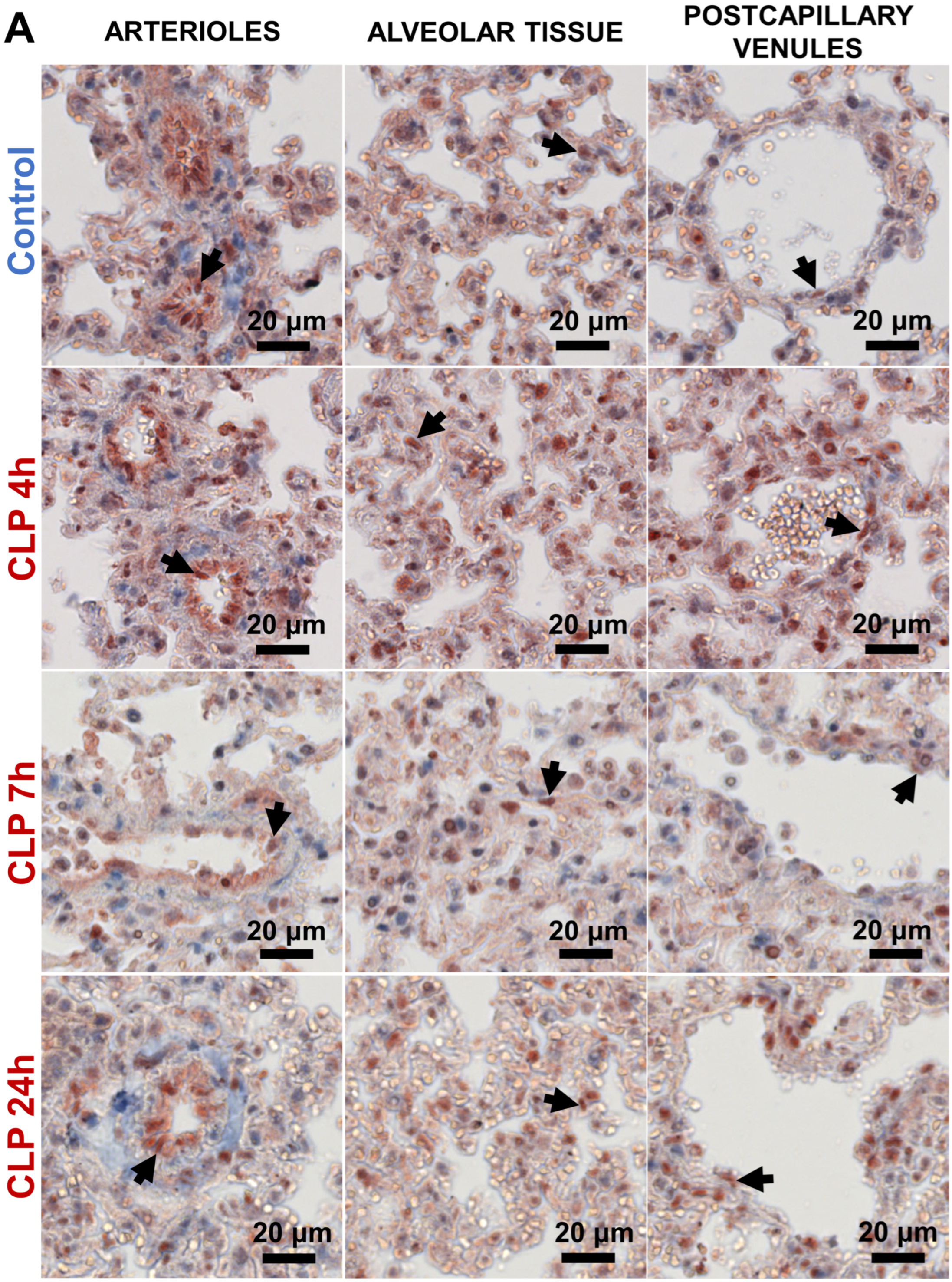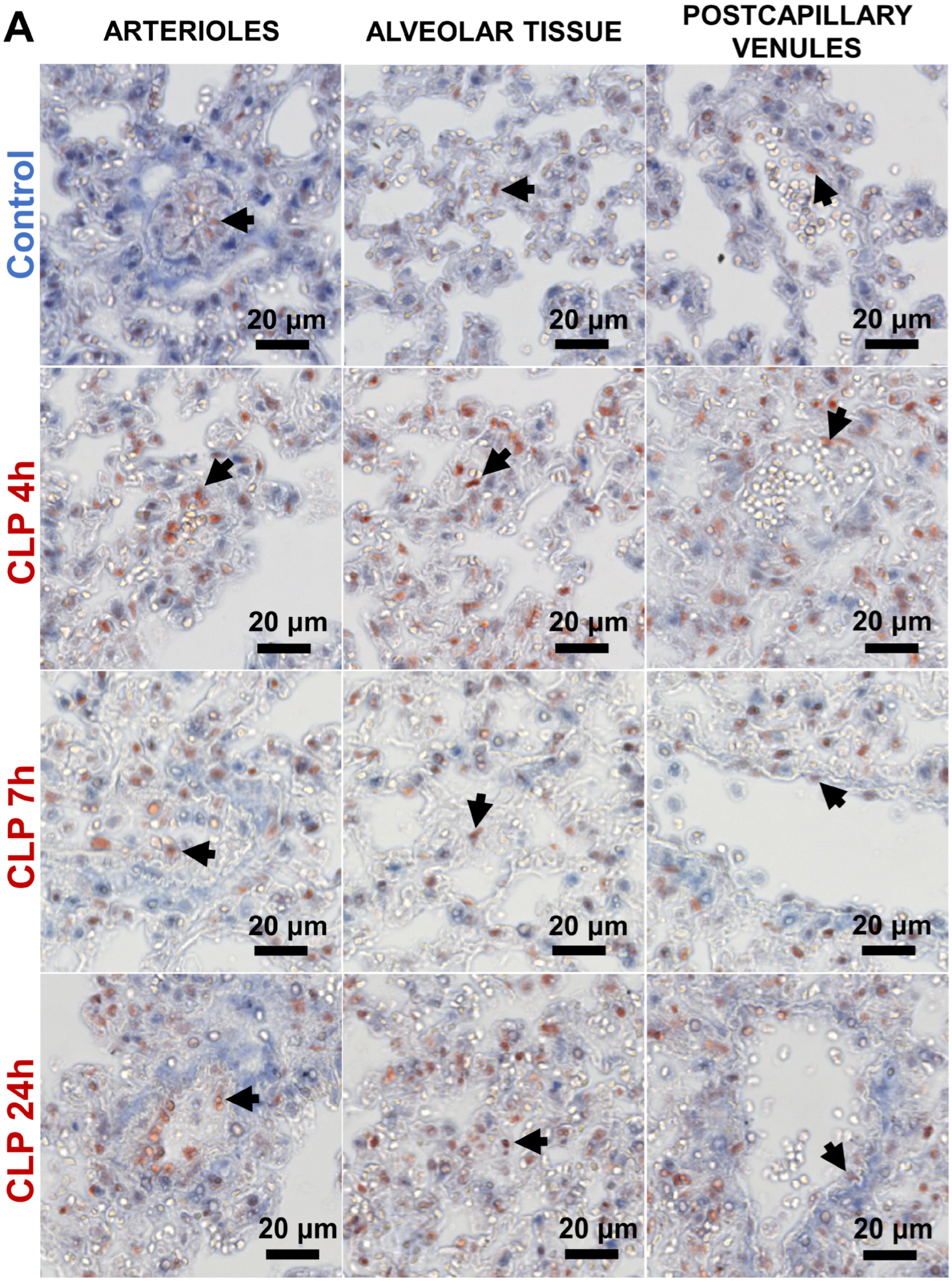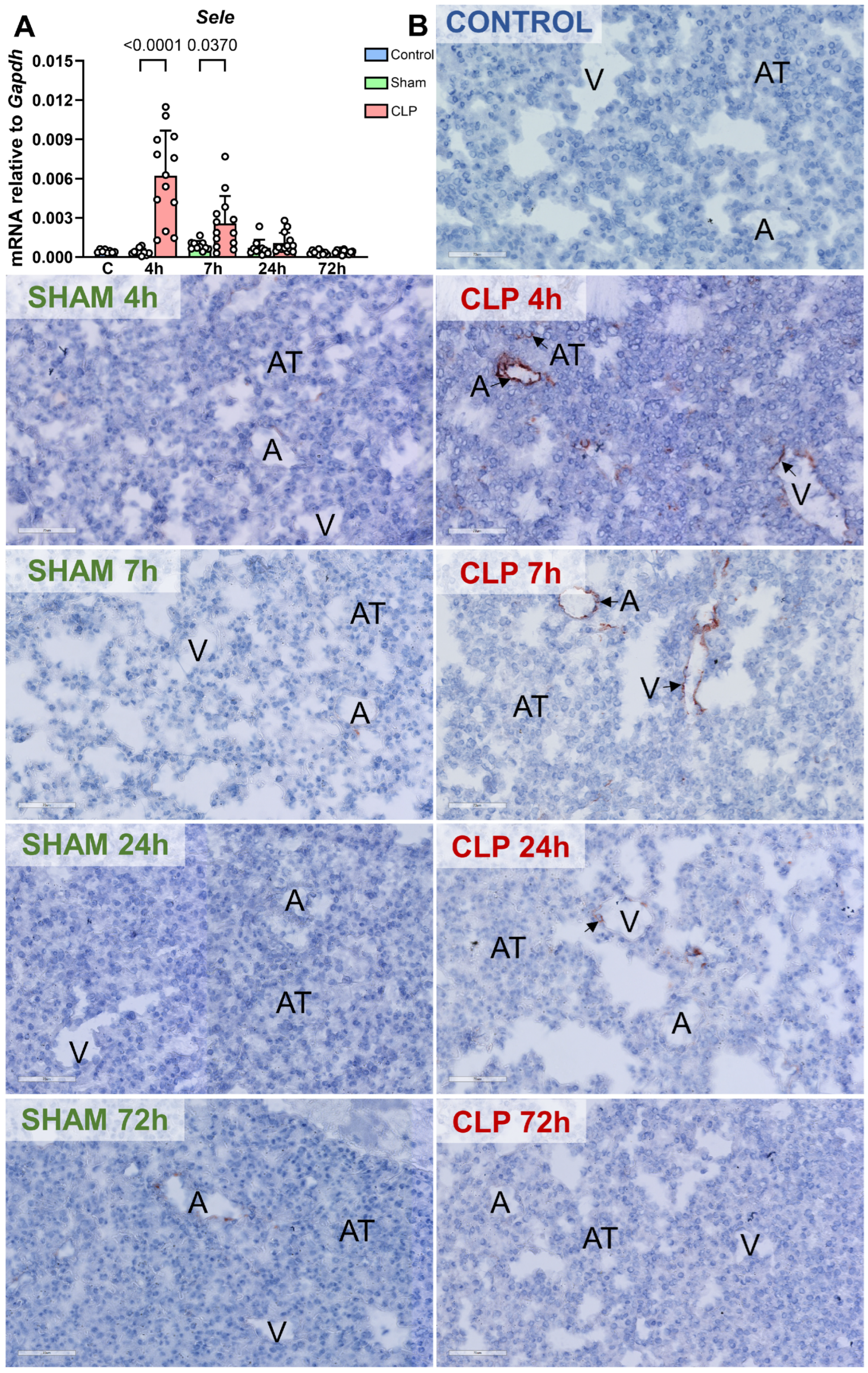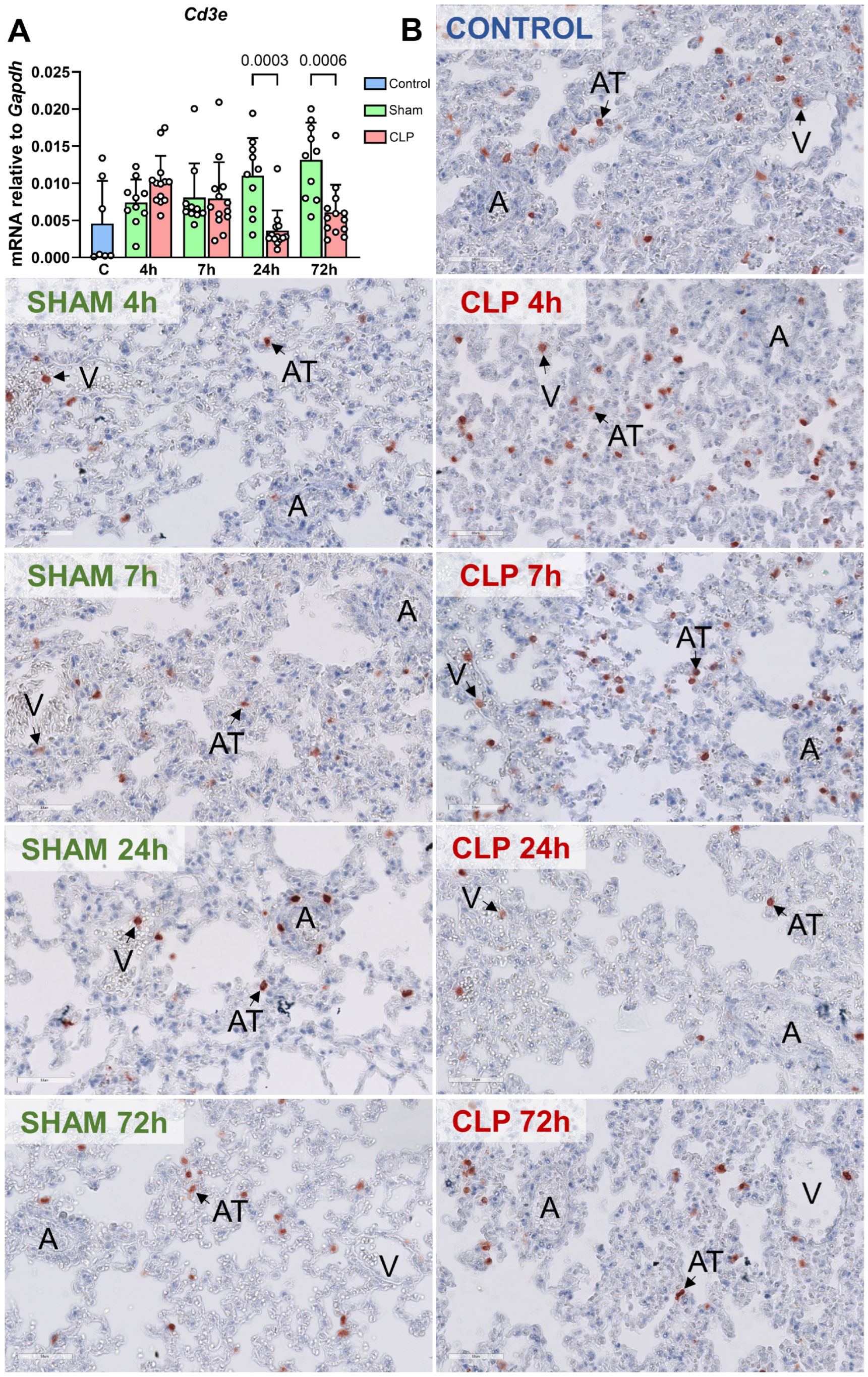Heterogeneous Patterns of Endothelial NF-κB p65 and MAPK c-Jun Activation, Adhesion Molecule Expression, and Leukocyte Recruitment in Lung Microvasculature of Mice with Sepsis
Abstract
:1. Introduction
2. Materials and Methods
2.1. Cecal Ligation and Puncture (CLP) Mouse Model
2.2. Immunohistochemical Staining
2.3. Scoring of Immunohistochemical Staining
2.4. Immunofluorescence Double Staining
2.5. Gene Expression Analysis by RT-qPCR
2.6. Myeloperoxidase (MPO) ELISA
2.7. Statistical Analyses
3. Results
3.1. NF-κB p65 Was Activated in EC in All Pulmonary Microvascular Beds during the First 24 h of Sepsis
3.2. MAPK c-Jun Was Activated in EC in All Pulmonary Microvascular Beds until 24 h after Sepsis Onset
3.3. In the Early Stage of CLP-Sepsis, E-Selectin Was Induced in Pulmonary Microvessels, Whereas VCAM-1 Expression Was Hardly Affected
3.4. Pulmonary Leukocyte Recruitment Occurred in a Time-Dependent Manner during CLP-Induced Sepsis
3.5. The Recruitment of Leukocyte Subsets Showed Different Spatiotemporal Patterns in Mouse Pulmonary Microvascular Beds during CLP-Induced Sepsis
4. Discussion
5. Conclusions
Supplementary Materials
Author Contributions
Funding
Institutional Review Board Statement
Informed Consent Statement
Data Availability Statement
Acknowledgments
Conflicts of Interest
References
- Jacobi, J. The pathophysiology of sepsis—2021 update: Part 2, organ dysfunction and assessment. Am. J. Health Syst. Pharm. 2022, 79, 424–436. [Google Scholar] [CrossRef]
- Xu, C.; Zheng, L.; Jiang, Y.; Jin, L. A prediction model for predicting the risk of acute respiratory distress syndrome in sepsis patients: A retrospective cohort study. BMC Pulm. Med. 2023, 23, 78. [Google Scholar] [CrossRef]
- Alizadeh-Tabrizi, N.; Hall, S.; Lehmann, C. Intravital Imaging of Pulmonary Immune Response in Inflammation and Infection. Front. Cell Dev. Biol. 2020, 8, 620471. [Google Scholar] [CrossRef]
- Maas, S.L.; Soehnlein, O.; Viola, J.R. Organ-Specific Mechanisms of Transendothelial Neutrophil Migration in the Lung, Liver, Kidney, and Aorta. Front. Immunol. 2018, 9, 2739. [Google Scholar] [CrossRef]
- Wang, F.; Chen, M.; Wang, C.; Xia, H.; Zhang, D.; Yao, S. Single-Cell Sequencing Reveals the Regulatory Role of Maresin1 on Neutrophils during Septic Lung Injury. Cells 2022, 11, 3733. [Google Scholar] [CrossRef] [PubMed]
- Dayang, E.Z.; Plantinga, J.; Ter Ellen, B.; van Meurs, M.; Molema, G.; Moser, J. Identification of LPS-Activated Endothelial Subpopulations With Distinct Inflammatory Phenotypes and Regulatory Signaling Mechanisms. Front. Immunol. 2019, 10, 1169. [Google Scholar] [CrossRef] [PubMed]
- Liu, B.; Wang, J.; Cheng, L.; Liang, J. Role of JNK and NF-kappaB pathways in Porphyromonas gingivalis LPS-induced vascular cell adhesion molecule-1 expression in human aortic endothelial cells. Mol. Med. Rep. 2013, 8, 1594–1600. [Google Scholar] [CrossRef]
- Pober, J.S.; Sessa, W.C. Evolving functions of endothelial cells in inflammation. Nat. Rev. Immunol. 2007, 7, 803–815. [Google Scholar] [CrossRef] [PubMed]
- Dayang, E.Z.; Luxen, M.; Kuiper, T.; Yan, R.; Rangarajan, S.; van Meurs, M.; Moser, J.; Molema, G. Pharmacological inhibition of focal adhesion kinase 1 (FAK1) and anaplastic lymphoma kinase (ALK) identified via kinome profile analysis attenuates lipopolysaccharide-induced endothelial inflammatory activation. Biomed. Pharmacother. 2021, 133, 111073. [Google Scholar] [CrossRef]
- Li, R.; Aslan, A.; Yan, R.; Jongman, R.M.; Moser, J.; Zwiers, P.J.; Moorlag, H.E.; Zijlstra, J.G.; Molema, G.; van Meurs, M. Histone Deacetylase Inhibition and IkappaB Kinase/Nuclear Factor-kappaB Blockade Ameliorate Microvascular Proinflammatory Responses Associated With Hemorrhagic Shock/Resuscitation in Mice. Crit. Care Med. 2015, 43, e567–e580. [Google Scholar] [CrossRef]
- Lockyer, J.M.; Colladay, J.S.; Alperin-Lea, W.L.; Hammond, T.; Buda, A.J. Inhibition of nuclear factor-kappaB-mediated adhesion molecule expression in human endothelial cells. Circ. Res. 1998, 82, 314–320. [Google Scholar] [CrossRef]
- Min, W.; Pober, J.S. TNF initiates E-selectin transcription in human endothelial cells through parallel TRAF-NF-kappa B and TRAF-RAC/CDC42-JNK-c-Jun/ATF2 pathways. J. Immunol. 1997, 159, 3508–3518. [Google Scholar] [CrossRef] [PubMed]
- Ye, X.; Ding, J.; Zhou, X.; Chen, G.; Liu, S.F. Divergent roles of endothelial NF-kappaB in multiple organ injury and bacterial clearance in mouse models of sepsis. J. Exp. Med. 2008, 205, 1303–1315. [Google Scholar] [CrossRef]
- Xu, Y.; Zhang, R.; Li, C.; Yin, X.; Lv, C.; Wang, Y.; Zhao, W.; Zhang, X. Dexmedetomidine attenuates acute lung injury induced by lipopolysaccharide in mouse through inhibition of MAPK pathway. Fundam. Clin. Pharmacol. 2015, 29, 462–471. [Google Scholar] [CrossRef] [PubMed]
- Su, J.; Chen, S.; Xiao, J.; Feng, Z.; Hu, S.; Su, Q.; Chen, Q.; Chen, D. Aloe-Emodin Ameliorates Cecal Ligation and Puncture-Induced Sepsis. Int. J. Mol. Sci. 2023, 24, 1972. [Google Scholar] [CrossRef]
- Seemann, S.; Zohles, F.; Lupp, A. Comprehensive comparison of three different animal models for systemic inflammation. J. Biomed. Sci. 2017, 24, 60. [Google Scholar] [CrossRef]
- Luxen, M.; Zwiers, P.J.; Jongman, R.M.; Moser, J.; Pultar, M.; Skalicky, S.; Diendorfer, A.B.; Hackl, M.; van Meurs, M.; Molema, G. Sepsis induces heterogeneous transcription of coagulation- and inflammation-associated genes in renal microvasculature. Thromb. Res. 2024, 237, 112–128. [Google Scholar] [CrossRef] [PubMed]
- Beckstead, J.H. A simple technique for preservation of fixation-sensitive antigens in paraffin-embedded tissues. J. Histochem. Cytochem. 1994, 42, 1127–1134. [Google Scholar] [CrossRef]
- Beckstead, J.H. A simple technique for preservation of fixation-sensitive antigens in paraffin-embedded tissues: Addendum. J. Histochem. Cytochem. 1995, 43, 345. [Google Scholar] [CrossRef]
- Bhasin, M.; Yuan, L.; Keskin, D.B.; Otu, H.H.; Libermann, T.A.; Oettgen, P. Bioinformatic identification and characterization of human endothelial cell-restricted genes. BMC Genom. 2010, 11, 342. [Google Scholar] [CrossRef]
- Kim, S.; Park, H.K.; Jung, H.Y.; Lee, S.Y.; Min, K.W.; Kim, W.Y.; Han, H.S.; Kim, W.S.; Hwang, T.S.; Lim, S.D. ERG Immunohistochemistry as an Endothelial Marker for Assessing Lymphovascular Invasion. Korean J. Pathol. 2013, 47, 355–364. [Google Scholar] [CrossRef] [PubMed]
- Gong, T.; Zhang, X.; Peng, Z.; Ye, Y.; Liu, R.; Yang, Y.; Chen, Z.; Zhang, Z.; Hu, H.; Yin, S.; et al. Macrophage-derived exosomal aminopeptidase N aggravates sepsis-induced acute lung injury by regulating necroptosis of lung epithelial cell. Commun. Biol. 2022, 5, 543. [Google Scholar] [CrossRef] [PubMed]
- Sikora, L.; Johansson, A.C.; Rao, S.P.; Hughes, G.K.; Broide, D.H.; Sriramarao, P. A murine model to study leukocyte rolling and intravascular trafficking in lung microvessels. Am. J. Pathol. 2003, 162, 2019–2028. [Google Scholar] [CrossRef] [PubMed]
- Bennewitz, M.F.; Watkins, S.C.; Sundd, P. Quantitative intravital two-photon excitation microscopy reveals absence of pulmonary vaso-occlusion in unchallenged Sickle Cell Disease mice. Intravital 2014, 3, e29748. [Google Scholar] [CrossRef] [PubMed]
- Wang, N.; Verna, L.; Hardy, S.; Forsayeth, J.; Zhu, Y.; Stemerman, M.B. Adenovirus-mediated overexpression of c-Jun and c-Fos induces intercellular adhesion molecule-1 and monocyte chemoattractant protein-1 in human endothelial cells. Arterioscler. Thromb. Vasc. Biol. 1999, 19, 2078–2084. [Google Scholar] [CrossRef] [PubMed]
- Barletta, K.E.; Cagnina, R.E.; Wallace, K.L.; Ramos, S.I.; Mehrad, B.; Linden, J. Leukocyte compartments in the mouse lung: Distinguishing between marginated, interstitial, and alveolar cells in response to injury. J. Immunol. Methods 2012, 375, 100–110. [Google Scholar] [CrossRef] [PubMed]
- van der Veen, B.S.; de Winther, M.P.; Heeringa, P. Myeloperoxidase: Molecular mechanisms of action and their relevance to human health and disease. Antioxid. Redox Signal 2009, 11, 2899–2937. [Google Scholar] [CrossRef] [PubMed]
- Wang, Y.; Roller, J.; Menger, M.D.; Thorlacius, H. Sepsis-induced leukocyte adhesion in the pulmonary microvasculature in vivo is mediated by CD11a and CD11b. Eur. J. Pharmacol. 2013, 702, 135–141. [Google Scholar] [CrossRef] [PubMed]
- Costa, M.F.; de Negreiros, C.B.; Bornstein, V.U.; Valente, R.H.; Mengel, J.; Henriques, M.; Benjamim, C.F.; Penido, C. Murine IL-17+ Vgamma4 T lymphocytes accumulate in the lungs and play a protective role during severe sepsis. BMC Immunol. 2015, 16, 36. [Google Scholar] [CrossRef]
- Charavaryamath, C.; Janardhan, K.S.; Caldwell, S.; Singh, B. Pulmonary intravascular monocytes/macrophages in a rat model of sepsis. Anat. Rec. A Discov. Mol. Cell Evol. Biol. 2006, 288, 1259–1271. [Google Scholar] [CrossRef]
- Arndt, P.G.; Young, S.K.; Lieber, J.G.; Fessler, M.B.; Nick, J.A.; Worthen, G.S. Inhibition of c-Jun N-terminal kinase limits lipopolysaccharide-induced pulmonary neutrophil influx. Am. J. Respir. Crit. Care Med. 2005, 171, 978–986. [Google Scholar] [CrossRef] [PubMed]
- Aslan, A.; van Meurs, M.; Moser, J.; Popa, E.R.; Jongman, R.M.; Zwiers, P.J.; Molema, G.; Zijlstra, J.G. Organ-Specific Differences in Endothelial Permeability-Regulating Molecular Responses in Mouse and Human Sepsis. Shock 2017, 48, 69–77. [Google Scholar] [CrossRef]
- Cleuren, A.; Molema, G. Organotypic heterogeneity in microvascular endothelial cell responses in sepsis-a molecular treasure trove and pharmacological Gordian knot. Front. Med. 2023, 10, 1252021. [Google Scholar] [CrossRef] [PubMed]
- Lewis, A.J.; Yuan, D.; Zhang, X.; Angus, D.C.; Rosengart, M.R.; Seymour, C.W. Use of Biotelemetry to Define Physiology-Based Deterioration Thresholds in a Murine Cecal Ligation and Puncture Model of Sepsis. Crit. Care Med. 2016, 44, e420–e431. [Google Scholar] [CrossRef] [PubMed]
- Luxen, M.; Zwiers, P.J.; Meester, F.; Jongman, R.M.; Kuiper, T.; Moser, J.; Pultar, M.; Skalicky, S.; Diendorfer, A.B.; Hackl, M.; et al. Unique miRNome and transcriptome profiles underlie microvascular heterogeneity in mouse kidney. Am. J. Physiol. Renal Physiol. 2023, 325, F299–F316. [Google Scholar] [CrossRef] [PubMed]
- Zhong, L.; Huot, J.; Simard, M.J. p38 activation induces production of miR-146a and miR-31 to repress E-selectin expression and inhibit transendothelial migration of colon cancer cells. Sci. Rep. 2018, 8, 2334. [Google Scholar] [CrossRef] [PubMed]
- Sun, X.; Icli, B.; Wara, A.K.; Belkin, N.; He, S.; Kobzik, L.; Hunninghake, G.M.; Vera, M.P.; Registry, M.; Blackwell, T.S.; et al. MicroRNA-181b regulates NF-kappaB-mediated vascular inflammation. J. Clin. Invest. 2012, 122, 1973–1990. [Google Scholar] [CrossRef] [PubMed]
- Yipp, B.G.; Kim, J.H.; Lima, R.; Zbytnuik, L.D.; Petri, B.; Swanlund, N.; Ho, M.; Szeto, V.G.; Tak, T.; Koenderman, L.; et al. The Lung is a Host Defense Niche for Immediate Neutrophil-Mediated Vascular Protection. Sci. Immunol. 2017, 2. [Google Scholar] [CrossRef] [PubMed]
- Lush, C.W.; Cepinskas, G.; Kvietys, P.R. LPS tolerance in human endothelial cells: Reduced PMN adhesion, E-selectin expression, and NF-kappaB mobilization. Am. J. Physiol. Heart Circ. Physiol. 2000, 278, H853–H861. [Google Scholar] [CrossRef]
- Bowden, R.A.; Ding, Z.M.; Donnachie, E.M.; Petersen, T.K.; Michael, L.H.; Ballantyne, C.M.; Burns, A.R. Role of alpha4 integrin and VCAM-1 in CD18-independent neutrophil migration across mouse cardiac endothelium. Circ. Res. 2002, 90, 562–569. [Google Scholar] [CrossRef]
- Lim, Y.C.; Garcia-Cardena, G.; Allport, J.R.; Zervoglos, M.; Connolly, A.J.; Gimbrone, M.A., Jr.; Luscinskas, F.W. Heterogeneity of endothelial cells from different organ sites in T-cell subset recruitment. Am. J. Pathol. 2003, 162, 1591–1601. [Google Scholar] [CrossRef] [PubMed]
- Mizgerd, J.P.; Meek, B.B.; Kutkoski, G.J.; Bullard, D.C.; Beaudet, A.L.; Doerschuk, C.M. Selectins and neutrophil traffic: Margination and Streptococcus pneumoniae-induced emigration in murine lungs. J. Exp. Med. 1996, 184, 639–645. [Google Scholar] [CrossRef] [PubMed]
- Carraway, M.S.; Welty-Wolf, K.E.; Kantrow, S.P.; Huang, Y.C.; Simonson, S.G.; Que, L.G.; Kishimoto, T.K.; Piantadosi, C.A. Antibody to E- and L-selectin does not prevent lung injury or mortality in septic baboons. Am. J. Respir. Crit. Care Med. 1998, 157, 938–949. [Google Scholar] [CrossRef] [PubMed]
- Myers, D., Jr.; Lester, P.; Adili, R.; Hawley, A.; Durham, L.; Dunivant, V.; Reynolds, G.; Crego, K.; Zimmerman, Z.; Sood, S.; et al. A new way to treat proximal deep venous thrombosis using E-selectin inhibition. J. Vasc. Surg. Venous Lymphat. Disord. 2020, 8, 268–278. [Google Scholar] [CrossRef] [PubMed]
- Zwiers, P.J.; Jongman, R.M.; Kuiper, T.; Moser, J.; Stan, R.V.; Gothert, J.R.; van Meurs, M.; Popa, E.R.; Molema, G. Pattern of tamoxifen-induced Tie2 deletion in endothelial cells in mature blood vessels using endo SCL-Cre-ERT transgenic mice. PLoS ONE 2022, 17, e0268986. [Google Scholar] [CrossRef]
- Schmidt, E.P.; Yang, Y.; Janssen, W.J.; Gandjeva, A.; Perez, M.J.; Barthel, L.; Zemans, R.L.; Bowman, J.C.; Koyanagi, D.E.; Yunt, Z.X.; et al. The pulmonary endothelial glycocalyx regulates neutrophil adhesion and lung injury during experimental sepsis. Nat. Med. 2012, 18, 1217–1223. [Google Scholar] [CrossRef]










| Epitopes and Antibodies | Species or Fluorophore | Working Concentration | Cat. No | Company |
|---|---|---|---|---|
| (μg/mL) | ||||
| E-selectin | Rat anti-mouse | 10 | clone MES-1 | Kind gift from Dr. Derek Brown |
| VCAM-1 | 10 | CBL1300 | Merck Millipore | |
| Ly6G | 3.33 | NBP2-00441 | Novus Biologicals, Centennial, CO, USA | |
| CD3 | 0.83 | MCA1477 | Bio-Rad | |
| IgG (H+L) | Rabbit anti-rat | 3.33 | AI-4001 | Vector Laboratories |
| CD68 | Rabbit anti-mouse | 2.5 | ab125212 | Abcam, Waltham, MA, USA |
| p65 | 0.53 | 8242 | Cell signaling, Danvers, MA, USA | |
| c-Jun | 0.48 | 9165 | ||
| ERG | 4.4 | ab92513 | Abcam | |
| ERG | Alexa Fluor488-rabbit anti-mouse | 5 | ab196374 | Abcam |
| IgG (H + L) highly cross-adsorbed secondary antibody | Alexa Fluor555-donkey anti-rabbit | 5 | A-31572 | Thermo Fisher Scientific |
| IgG1 | Rat | 5 | 0116-01 | Southern Biotech, Birmingham, AL, USA |
| IgG2a | 5 | 0117-01 | ||
| IgG2b | 5 | 0118-01 | ||
| IgG | Rabbit | 0.5 | 0111-01 |
| Reagents | Quantity | Cat. No | Source of Buffer Component |
|---|---|---|---|
| 3-amino-9-ethylcarbazole | 1 tablet | #A6926 | Sigma-Aldrich |
| dimethylformamide | 7.5 mL | #1.03034 | Merck Millipore |
| H2O2 | 150 μL | #1072090250 | Merck Millipore |
| acetate buffer | 15 mL, 1 mol/L, pH 5.5 | UMCG, Pathology and Medical Biology department, in-house prepared | |
| deionized water | 135 mL | ||
| Reagents | Total Volume | Quantity Used | pH | Source of Buffer Component |
|---|---|---|---|---|
| 1 mM EDTA | 1 L demi water | Na2-EDTA, 372 mg | 8.0 | E1644, Lot#SLBF8074V, Sigma |
| 10 mM Tris/1 mM EDTA | Tris Base, 1.21 g | 9.0 | 648311, Lot#3244015, Millipore | |
| Na2-EDTA, 372 mg | E1644, Lot#SLBF8074V, Sigma | |||
| 0.1 M Tris/HCl | Tris Base, 12 g | 9.0 | 648311, Lot#3244015, Millipore |
| Table | Gene ID | Assay ID | Encoded Protein |
|---|---|---|---|
| Sele | 20339 | Mm00441278_m1 | E-selectin |
| Vcam1 | 22329 | Mm00449197_m1 | Vascular cell adhesion protein 1 |
| Ptprc | 19264 | Mm01293577_m1 | Protein tyrosine phosphatase, receptor type, C (a.k.a. Cluster of differentiation CD45) |
| Cd68 | 12514 | Mm03047343_m1 | Cluster of Differentiation 68 |
| Gapdh | 14433 | Mm99999915_g1 | Glyceraldehyde 3-phosphate dehydrogenase |
Disclaimer/Publisher’s Note: The statements, opinions and data contained in all publications are solely those of the individual author(s) and contributor(s) and not of MDPI and/or the editor(s). MDPI and/or the editor(s) disclaim responsibility for any injury to people or property resulting from any ideas, methods, instructions or products referred to in the content. |
© 2024 by the authors. Licensee MDPI, Basel, Switzerland. This article is an open access article distributed under the terms and conditions of the Creative Commons Attribution (CC BY) license (https://creativecommons.org/licenses/by/4.0/).
Share and Cite
Wang, Z.; Dayang, E.-Z.; Zwiers, P.J.; Hernandez Garcia, M.L.; Luxen, M.; van Meurs, M.; Moser, J.; Kamps, J.A.A.M.; Molema, G. Heterogeneous Patterns of Endothelial NF-κB p65 and MAPK c-Jun Activation, Adhesion Molecule Expression, and Leukocyte Recruitment in Lung Microvasculature of Mice with Sepsis. Biomedicines 2024, 12, 1672. https://doi.org/10.3390/biomedicines12081672
Wang Z, Dayang E-Z, Zwiers PJ, Hernandez Garcia ML, Luxen M, van Meurs M, Moser J, Kamps JAAM, Molema G. Heterogeneous Patterns of Endothelial NF-κB p65 and MAPK c-Jun Activation, Adhesion Molecule Expression, and Leukocyte Recruitment in Lung Microvasculature of Mice with Sepsis. Biomedicines. 2024; 12(8):1672. https://doi.org/10.3390/biomedicines12081672
Chicago/Turabian StyleWang, Zhendong, Erna-Zulaikha Dayang, Peter J. Zwiers, Martha L. Hernandez Garcia, Matthijs Luxen, Matijs van Meurs, Jill Moser, Jan A. A. M. Kamps, and Grietje Molema. 2024. "Heterogeneous Patterns of Endothelial NF-κB p65 and MAPK c-Jun Activation, Adhesion Molecule Expression, and Leukocyte Recruitment in Lung Microvasculature of Mice with Sepsis" Biomedicines 12, no. 8: 1672. https://doi.org/10.3390/biomedicines12081672





